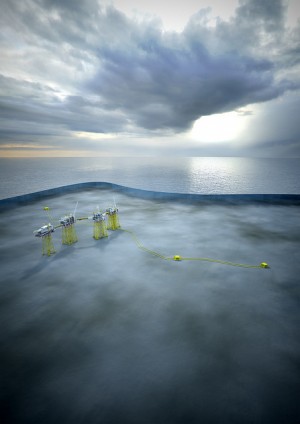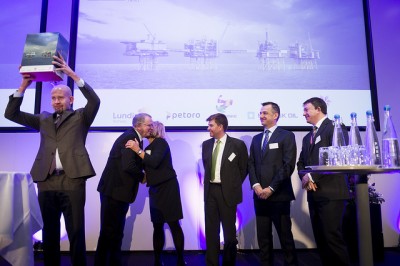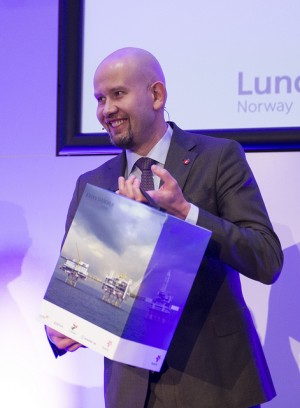Norway’s new Johan Sverdrup oil field, located just 140 kilometers off the coast of Stavanger, may be as important for the Norwegian economy as the country’s Ekofisk and Statfjord fields have been. It has also attracted huge development investment at a time when the oil industry otherwise is struggling with the dive in oil prices, but the field’s license partners have failed to agree over how their ownership stakes in the project should be divvied up.

Four out of the five main partners in the license for development of the Johan Sverdrup field have agreed on the size of their stakes. Statoil, which discovered the field’s huge oil reserves in 2010 when it was still called the “Aldous prospect,” has the biggest stake with 40 percent, followed by Lundin Norway with 22.1 percent, the state’s own direct stake through Petoro of 17.8 percent and Mærsk with 8.1 percent.
Industrialist Kjell Inge Røkke, however, is reportedly unhappy with the 11.9 percent stake that his interests ended up with after three years of negotiations among the partners. Røkke owns 68 percent of Aker ASA which in turn owns 50 percent of Det norske oljeselskap. Røkke wants Det norske to get a bigger share of the value of Johan Sverdrup, and now it’s up to Oil Minister Tord Lien to decide whether he will, possibly at the other partners’ expense.
Newspaper Dagens Næringsliv (DN) reported on Thursday that Røkke, who effectively owns 49.99 percent of Det norske through his Aker holdings, is asking for between 1- and 2.5 percentage points more than what Det norske was granted. That could boost Det norske’s stake to as much as 14.4 percent of Johan Sverdrup, which DN reported would mean up to NOK 1 billion more in field value for Røkke personally and NOK 3 billion extra for Det norske.
Analysts have set the value of the Johan Sverdrup field at as much as NOK 118 billion, based on the value of its oil minus its development costs after tax. Det norske itself has argued that the value of the stakes that both it and Petoro have in the western portions of the field are worth more than those that Lundin and Mærsk have in the east.
“This isn’t about tactics, but principles,” Det norske’s spokesman, Rolf Jarle Brøske, told DN. “We believe the balance between volume and value isn’t represented in the agreement as it stands today.”

All five partners went ahead and handed in their development and operation plans for Johan Sverdrup anyway last Friday, which Oil Minister Lien described as an “historic” and “exceptional” day for the entire country. “This oil field will finance the welfare state for many decades ahead,” Lien exclaimed, at a time when the government in which he sits is otherwise warning that Norway needs to diversify its economy and be less dependent on its oil industry. Lien, though, has expressed confidence that Norway’s oil industry is far from drying up and he has almost seemed overwhelmed by Johan Sverdrup’s prospects for generating new oil fortunes, despite the ever-present environmental concerns.
The field has indeed won international acclaim for its sheer size and potential, and the conflict among its partners isn’t expected to delay the field’s development. Wood Mackenzie, a leading oil industry analysis firm, declared over the weekend that Johan Sverdrup “is a major success story for Norway,” calling it “the crowning achievement” of Norway’s “successful rejuvenation of exploration in more mature areas” of the North Sea.
‘Immune’ to capital spending cuts
“The world class Johan Sverdrup oil field has proven immune to cuts in (oil industry) capital spending, standing out in a barren year for project sanctions,” said Malcolm Dickson, Norway Upstream research analyst at Wood Mackenzie, which has itself valued the field at USD 11.2 billion based on a break-even oil price for North Sea Brent crude of USD 41 a barrel.
With oil prices edging back up this week, to USD 61.50 a barrel by early Thursday, it’s not difficult to see the value of Johan Sverdrup in the years to come. It’s a unique project, analysts note, because it’s located in relatively easily accessible waters where there already exists oil industry infrastructure and where extraction costs are much lower than in deep water or harsher, remote areas like the Barents Sea. Newspaper Aftenposten recently noted that Johan Sverdrup is one of the largest fields ever to be tapped on the Norwegian Continental Shelf, that it’s expected to be able to produce oil for another 50 years, that it can be profitable despite the fall in oil prices, that it can generate enormous revenues for the state treasury and Norway’s sovereign wealth fund known as the “oil fund,” and that it can produce an estimated 51,000 jobs. And all in an area that’s not as environmentally sensitive as the frigid waters of the Arctic where there’s ongoing controversy over drilling too close to the polar ice.

Det norske’s disagreement threw some cold water over last Friday’s festivities when the license partners’ development plans were formally presented to Lien only after what DN called an “intense” power struggle. It was the first time a development plan was presented without all the oil companies involved agreeing despite a reported 300 meetings over the past three years. There may be more conflict among the partners in 2025, when they did manage to agree to reevaluate their percentage stakes after seeing how the field is actually performing.
“The project is huge, the volumes are huge, there’s no question that huge values are at stake,” Karl Johnny Hersvik, chief executive of Det norske, told DN. Others were surprised the partners failed to agree. “Normally they do agree, if only at the last minute,” said Bente Nyland, director of Norway’s oil directorate, told DN. “This involves a lot of money, and huge value can be changed just by moving a percentage point.”
Meanwhile, Lien’s ministry and Norway’s petroleum authority will determine partnership stakes in Johan Sverdrup. Det norske risks seeing its stake reduced, but that’s a risk it’s apparently willing to take. Lien wouldn’t speculate on an outcome. “We will now need to evaluate this, but I want to make it clear that this is a decision that should have been made by them, and not by us,” Lien said, hastening to confirm that the disagreement won’t delay the project.
Statoil’s new CEO, Eldar Sætre, preferred to concentrate on the positive aspects of Johan Sverdrup itself, instead of the partnership quarrel. “This plan is the most comprehensive for the Norwegian shelf since the giant projects of the the 1980s,” Sætre said last Friday. “This is an historic day, I hope you all understand that.”
newsinenglish.no/Nina Berglund

